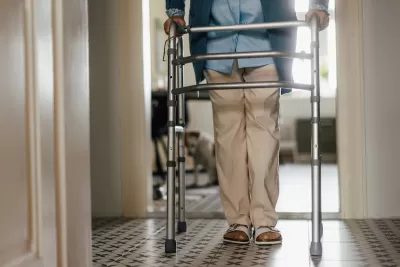Why developers should place more emphasis on building homes for aging residents and multigenerational living.

“Come 2034, there will be more adults age 65 and older than children, according to U.S. Census Bureau projections,” writes Lydia Lee in Builder Online. And according to an AARP survey, roughly 90 percent of those over 65 would prefer to stay in their current homes or communities as they age.
This has major implications for the building industry, Lee writes, as “very little of the current housing stock is designed for those with mobility challenges,” and no legal requirements like the Americans with Disabilities Act (ADA), which applies to public spaces and businesses, exists for homes.
According to a 2020 report from the U.S. Census Bureau, just one in 10 American homes are ‘aging-ready.’ “These aging-ready homes address the two core needs—single-floor living and bathroom accessibility—by providing a zero-step entry, a first-floor bedroom, and a full first-floor bathroom with at least one accessibility feature.”
A movement based around a new term, ‘visitability,’ mandated in some parts of the United States, including Pima County, Arizona and Vermont, seeks to address these issues by calling on builders to make all new homes more easily accessible with flush thresholds, ground-floor doorways with minimum clearance for wheelchairs, and ground-floor bathrooms large enough for wheelchairs. “Another key idea behind the term is that people should be able to visit others easily—that our social lives shouldn’t be impeded by mobility issues.”
Advocates say aging in place also applies to the broader community outside a person’s home. Some communities aimed at seniors ensure that shopping, social destinations, and other amenities are within walking distance, with lots of places to sit and shade trees to protect people from heat.
FULL STORY: Why Builders and Developers Should Be Constructing More Aging-Ready Homes

Maui's Vacation Rental Debate Turns Ugly
Verbal attacks, misinformation campaigns and fistfights plague a high-stakes debate to convert thousands of vacation rentals into long-term housing.

Planetizen Federal Action Tracker
A weekly monitor of how Trump’s orders and actions are impacting planners and planning in America.

In Urban Planning, AI Prompting Could be the New Design Thinking
Creativity has long been key to great urban design. What if we see AI as our new creative partner?

Car Designs Make it Harder to See Pedestrians
Blind spots created by thicker pillars built to withstand rollover crashes are creating dangerous conditions for people outside vehicles.

Cal Fire Chatbot Fails to Answer Basic Questions
An AI chatbot designed to provide information about wildfires can’t answer questions about evacuation orders, among other problems.

What Happens if Trump Kills Section 8?
The Trump admin aims to slash federal rental aid by nearly half and shift distribution to states. Experts warn this could spike homelessness and destabilize communities nationwide.
Urban Design for Planners 1: Software Tools
This six-course series explores essential urban design concepts using open source software and equips planners with the tools they need to participate fully in the urban design process.
Planning for Universal Design
Learn the tools for implementing Universal Design in planning regulations.
Appalachian Highlands Housing Partners
Gallatin County Department of Planning & Community Development
Heyer Gruel & Associates PA
Mpact (founded as Rail~Volution)
City of Camden Redevelopment Agency
City of Astoria
City of Portland
City of Laramie


























